Maltese Falcon, The (4K UHD Review)

Director
John HustonRelease Date(s)
1941 (April 4, 2023)Studio(s)
Warner Bros. Pictures (Warner Bros. Home Entertainment)- Film/Program Grade: A+
- Video Grade: A+
- Audio Grade: B+
- Extras Grade: B
Review
Based on the popular 1930 novel by ex-Pinkerton turned author Dashiell Hammett, John Huston’s The Maltese Falcon follows a San Francisco private investigator named Sam Spade (Humphrey Bogart, in the role that made him famous), who is hired by a New York woman named Ruth Wonderly (Mary Astor) to find her missing sister. It seems the sister came to town with a man named Floyd Thursby, so Spade’s partner Miles Archer (Jerome Cowan) agrees to tail Thursby, hoping to find her. But when Archer ends up getting shot and killed, the local police quickly focus their attention on Spade, who we learn has been having an affair with Archer’s wife. After Thursby turns up dead as well, Wonderly tells Spade that her original story was a lie—there is no sister. Revealing her real name to be Brigid O’Shaughnessy, she claims that Thursby was actually her business partner, and now she’d like Spade to investigate his death.
Into this picture comes a foreign dandy named Joel Cairo (Peter Lorre, M, The Man Who Knew too Much), who offers to pay Spade $5,000 for the recovery of a black statue in the shape of a bird—the titular Maltese Falcon—to which it seems Thursby and O’Shaughnessy are somehow connected. Cairo claims to work for its rightful owner, but wants no questions asked and pulls a gun on Spade trying to search his office for the Falcon, which he thinks Spade has already found. Spade quickly disarms Cairo and strikes a deal with him, but soon finds himself being tailed by a man working for yet another interested party, Kasper Gutman (alias the “Fat Man” played by Sydney Greenstreet). So now, not only must Spade clear his name for Archer’s murder, he needs to find the Falcon too. And all he knows for sure is that everyone is lying to him... and the Maltese Falcon is worth a lot more than any of them are letting on.
Having written several successful screenplays under contract to the studio in the late 1930s, John Huston was finally able to persuade Warner Bros. to give him a chance to direct in early 1941. Yet his choice to adapt the popular Hammett novel for the screen was interesting, as the studio had already tried twice with the property and failed both times at the box office. But Huston’s script succeeded by hewing more closely to the novel, retaining much of the author’s original dialogue, and its characters benefitted greatly from a terrific cast of then-relatively unknown players, many of whom already had a good working relationship with Huston. Shot on the Warner backlot’s famous New York Street, the first-time director not only delivered the picture on time, he did so on a B-movie budget, and to a degree of almost instant critical and public acclaim that took the studio by surprise, thus cementing Huston’s reputation at the time as one of the great young filmmaking talents in Hollywood.
It’s easy to understand why audiences and critics responded so positively to The Maltese Falcon. For one thing, the film was beautifully shot by cinematographer Arthur Edeson (The Thief of Bagdad, Frankenstein, Casablanca), whose masterful and expressionistic use of lighting, shadows, and camera angles speaks volumes about each character’s true intentions. A obvious example is a low shot of Greenstreet’s Gutman—during his first meeting with Spade—that emphasizes the man’s comfortable greed and questionable morals. When the characters speak, they’re fast talking and elusive, most of them downright cynical, yet each is necessary to the story in their own way. That story is itself an ouroboros of twists and revelations that keeps the viewer guessing until the very end. Not only is Bogart compelling as the film’s hard-boiled lead, Astor is remarkably shifty as his femme fatale. Every time you think you’ve got a bead on her, she reveals another yet layer of duplicity, but she and Bogart have enough chemistry onscreen that you can understand why his character is attracted to her even as he knows he’s getting played. What’s more, Greenstreet and Lorre nearly steal every scene they’re in. When Greenstreet (astonishingly, seen here in his first film performance) explains the history of the Falcon, you’re drawn to his every word and it’s only after the scene is over that you realize he’s just delivered a seven-minute monologue in a single take. Meanwhile, Lorre’s Cairo is amusingly oily, reptilian, and self-serving, always seeking to take advantage in every dealing. And despite his freshman experience behind the camera, Huston’s direction is efficient indeed. Combined with deft editing by Thomas Richards, Huston somehow manages to make a dialogue-heavy drama set mostly in rooms feel like a tense and suspenseful action thriller. The film earns points too for smaller roles by Ward Bond (It’s a Wonderful Life) and Elisha Cook Jr. (who Star Trek fans might recognize as the lawyer Samuel T. Cogley from The Original Series episode Court Martial).
The Maltese Falcon was shot on 35 mm black and white film (specifically Eastman Plus-X 1231 stock) using Mitchell BNC cameras with spherical lenses (Edeson reportedly favored a personally-owned 21 mm wide-angle for this production), and it was finished at the 1.37:1 Academy ratio typical of the period. While there are no restoration notes available, studio sources have confirmed that Warner Bros. Motion Picture Imaging completed a new 16-bit 4K scan and frame-by-frame digital remastering of the original camera negative earlier this year (and it’s worth noting that the entire original negative for this film actually does survive in good condition). The image was then carefully graded for High Dynamic Range for its Ultra HD release (HDR10 alone is available on this disc). The result is absolutely stunning, a gorgeous presentation that exhibits a significant uptick in resolution and refinement compared to the previous Blu-ray edition. Extremely deep blacks are in evidence, along with luminous highlights, and much greater variation in grayscale than ever before. Fine detail is crisp and clean, with more nuanced texturing too, an improvement that’s readily apparent in facial features, hair, costume textiles, furniture, and brickwork. Archer’s tweed suit in the opening scene, for example, reveals its intricate herringbone pattern with ease. You can nearly read the text on the business license in Spade’s office, not to mention the instructions on the pay phone he uses early in the film. The worn paint and wallpaper in his apartment too are remarkably detailed. Photochemical grain is light to moderate but controlled and natural looking at all times. To the extent that there’s any softness in the image at all, it’s found in optically-printed transitions or slight variations in the depth of focus in low-lighting conditions. But it seems abundantly clear that every bit of detail available in the negative is visible on screen.
The film’s original mono soundtrack has also been restored to enhance its overall clarity and frequency response. You’ll find it here in lossless English 2.0 in DTS-HD Master Audio format (note that the previous Blu-ray included 1.0 mono in DTS-HD MA). The overall tonal quality is full and pleasing. Dialogue is clean and free of unwanted distortion and hiss, while Max Steiner’s score is presented in good fidelity. Additional 2.0 mono Dolby Digital tracks are available in German, Spanish, and Portuguese, while subtitle options include English (for the Hearing Impaired), French, German (for the Hearing Impaired), Spanish, Brazilian Portuguese, Danish, Finnish, Greek, Norwegian, Portuguese, and Swedish.
Warner’s new Ultra HD release is a 2-disc set that includes the film in 4K on UHD and 1080p HD on Blu-ray (the same disc released in 2010—it’s not mastered from the new 4K scan). Both discs include the following special feature:
- Audio Commentary with Eric Lax
To this, the Blu-ray adds the following:
- Warner Night at the Movies
- Sergeant York Theatrical Trailer (SD – 2:00)
- Newsreel (SD – 1:25)
- The Gay Parisian (SD – 20:02)
- Hiawatha’s Rabbit Hunt (SD – 7:47)
- Meet John Doughboy (HD – 7:00)
- Behind the Story
- The Maltese Falcon: One Magnificent Bird (SD – 32:05)
- Extras
- Becoming Attractions: The Trailers of Humphrey Bogart (SD – 44:45)
- Breakdowns of 1941 (SD – 12:53)
- Makeup Tests (SD – 1:16)
- Audio Vault
- 2/8/1943 – Lux Radio Broadcast (57:39)
- 9/20/1943 – Screen Guild Theater Broadcast (28:46)
- 7/3/1946 – Academy Award Theater Broadcast (27:34)
- Trailers
- Satan Met a Lady (SD – 2:30)
- The Maltese Falcon (SD – 2:44)
All of these extras were included on the film’s 2006 special edition DVD (though Meet John Doughboy was subsequently upgraded to HD for the Blu-ray release). They begin with a fine and workmanlike audio commentary by author and biographer Eric Lax (Bogart), who delivers a steady stream of trivia, historical detail, context, and production anecdotes. As always, the Warner Night at the Movies program recreates the audience experience of this film in theaters during its original release, including all of the cartoons, newsreels, trailers, and short subjects seen before the main attraction back in 1941. The Maltese Falcon: One Magnificent Bird is a solid retrospective featurette on the film that offers video interview clips with Lax, along with filmmaker Peter Bogdanovich, Julie Rivett (the granddaughter of Dashiell Hammett), authors Joe Gorges, Eddie Muller, Richard Layman, Stephen Youngkin, Eric Lax, and Frank Miller (of Sin City fame), film historians Rudy Behlmer and Lincoln D. Hurst, screenwriters Larry Cohen and Michael B. Druxman, film editor Carol Littleton, cinematographer Roger Deakins, and actors Michael Madsen and James Cromwell. It also includes glimpses of the two earlier WB adaptations as well as studio notes, photographs, and other documents. Becoming Attractions is a 1996 Turner Classic Movies special hosted by Robert Osborne that profiles Bogart’s career using many of the trailers created to market his films. Breakdowns of 1941 is essentially a blooper reel of outtakes from other Warner films made the same year as The Maltese Falcon. You also get a bit of Mary Astor’s makeup test footage, audio of three different radio adaptations of the book (including one featuring Edward G. Robinson and two others with Bogart, Astor, and Greenstreet recreating their roles), the film’s trailer, and a trailer for Satan Met a Lady (1936)—one of the studio’s aforementioned earlier adaptations starring Betty Davis. Missing from the 2006 DVD release are those actual SD versions of Satan Met a Lady and The Maltese Falcon (1931). There are no new extras here for the 4K release. A Digital Copy code is also included on a paper insert and the package comes with a lovely slipcover that features Warner Bros. 100th Anniversary branding.
As successful as The Maltese Falcon was upon its release in 1941, it only hinted at the greatness of actor Humphrey Bogart, whose rise to stardom began with High Sierra, grew with this film, and launched into the stratosphere with Casablanca, all in the space of just two years. (And it’s worth noting that Bogart’s roles in each of these films were first offered to actor George Raft, who turned them all down.) But film noir is where Bogart truly shined, and John Huston’s The Maltese Falcon is often regarded as one of the genre’s first and greatest exemplars. Thankfully, Warner’s new 4K restoration is a wonder, delivering the film in best-ever image quality that should delight cinephiles of all stripes. If you count yourself among them, this Ultra HD is a must-have release for any serious collection.
- Bill Hunt
(You can follow Bill on social media at these links: Twitter and Facebook)

